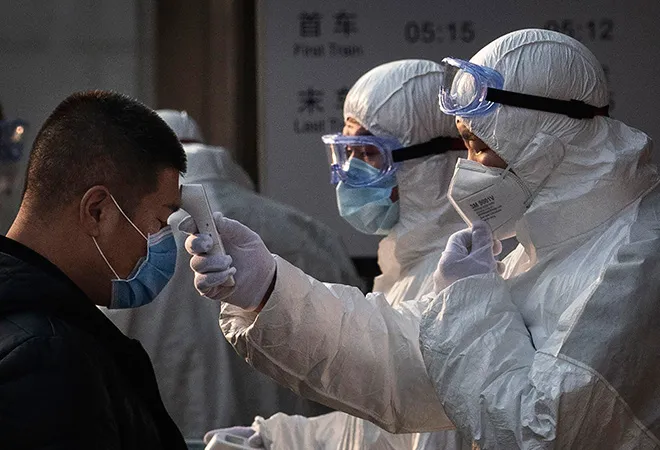
As arguably the most potent disruptors in recent history, Covid19 has split wide open a number of concerns which the world was largely debating to different degrees up until now, but is now being forced to take on with a more headfirst approach. Even before November 2019 — when the first cases of the virus had surfaced in China and which the rest of the world got to know much later — the world was deliberating on for instance, digitisation and the best practices for information sharing, but the outbreak of Covid19 has brought urgency and inevitability to the need for multilateral efforts in an already rapidly transforming world.
With the 4IR, technology has stridently arrived as the most vital foundation, as we move forward in a world that is increasingly growing smaller and closer with respect to connectivity networks. Innovations in and applications of technology are happening simultaneously and at breakneck speed. But what has been progressively evident is the fact that there exist gaps, albeit to varying degrees, in terms of the readiness of countries and institutions towards adopting and implementing technological solutions. While on the one hand readiness is predicated on capabilities and attendant challenges such as the impact on physical and financial capital, it is on the other hand also contingent upon the willingness to shift gradually but surely towards structures that are more integrated, more efficient and more responsive.
What has been progressively evident is the fact that there exist gaps, albeit to varying degrees, in terms of the readiness of countries and institutions towards adopting and implementing technological solutions.
For instance, much of India’s healthcare is still pre-digital with the country often being regarded as ‘the land of pilots.’ In addition to other response measures the Prime Minister has announced the Covid19 Solution Challenge urging inputs from individuals and companies to harness technologies and innovative solutions, bioinformatics, datasets, apps for diagnosis, and so on. While these responses are necessary, they are not structural in nature and the government must work to standardising the solutions now and for future reference.
Covid19 underscores the necessity for digitisation and digital infrastructures for healthcare systems. This is imperative not only because it creates scope for a ready repository of medical records which can be accessed in times of acute crisis but also because it allows for responses to be more efficient. Taiwan is an illustrative case in point. Despite being in close geographical proximity to China and with there being several weekly flights operating between Wuhan and Taipei until as recently as January 2020, Taiwan has emerged as among the few countries which have successfully managed to keep the contagion from spreading by putting in place effective early responses, comprehensive screenings and testings, and very importantly, the dexterous use of technology.
Since the adoption of the nationwide health insurance system in 1995, the healthcare system in Taiwan has been characterised by excellent accessibility, comprehensive population coverage at around 99%, national data collection systems for planning and research, reasonable costs and short waiting times. While weaknesses such as weak referral systems and financial issues remain, the systemic structures that are in place are commendable. Taiwan is a centre for cutting-edge medical technologies and top quality hospitals with an International Health Care Index (2019) of 78.72 points out of 100 in terms of overall quality of healthcare, including infrastructure, competencies of staff, cost, availability and government readiness with the Medtech industry estimated to become a $595 billion industry by 2024. It is a leading country for medical services and medical tourism. Various policy initiatives have made these developments possible for Taiwan such as government-backed venture capital, comprehensive knowledge-based, financial and resource investments in artificial intelligence (AI) and reaping the benefits of its advances in intelligent tech and software solutions.
Since the adoption of the nationwide health insurance system in 1995, the healthcare system in Taiwan has been characterised by excellent accessibility, comprehensive population coverage at around 99%, national data collection systems for planning and research, reasonable costs and short waiting times.
Some of these developments such as the spotlight on AI have been prompted by the realities of a population that is soon to become a ‘super ageing’ one. The 5+2 Industrial Innovation Plan launched and led by the Tsai government has been pivotal in significantly advancing the country’s capabilities as a global leader in ICT with the five pillar industries being the Internet of Things, biomedical, green energy, smart machinery, and defence to which high-value agriculture and the circular economy were later added.
It can of course be argued that the maintenance of such a comprehensive and relatively efficient system is possible because Taiwan is a small country. But this argument would not hold water if the systems existing in other countries are reorganised along the broad structural framework that an arrangement like the one in Taiwan allows for. Indeed it is all the more essential for larger nations with bigger populations to plan for and have effective systemic infrastructure which would prove inimitable in times of crisis. And a big part of the move towards such infrastructures is going digital.
It can also be posited that the political and cultural systems of Taiwan and other East Asian nations permit comprehensive surveillance and data collection which may not be accepted by liberal democracies elsewhere. It must be understood that data and records are fundamentals of coping with populations at a large scale — and necessary in so far as mitigating and addressing a pandemic like the Covid19. Therefore there needs to be informed, objective intensive deliberations with respect to the extent, nature, scope and accessibility of public records to address natural misgivings regarding the slippery slope of surveillance.
It must be understood that data and records are fundamentals of coping with populations at a large scale — and necessary in so far as mitigating and addressing a pandemic like the Covid19.
The best defence is always knowledge and information sharing is critical especially in cases of a global pandemic. Since Covid19 became public knowledge, information regarding its spread and the known symptoms at different points in time have been shared through social networks at an unprecedented scale. This has undoubtedly enabled more numbers of people to be informed of the spread of the virus together with the available facts regarding the course of symptoms. Despite the fact that the Covid19 went swiftly from being an outbreak to an epidemic and now a pandemic, the bulk and frequency of information has allowed people to be better informed. While with respect to the spread of information, it must be acknowledged that technology can be a double edged sword as instances of misinformation abound, the only way to counter is also via technological applications which involves spreading of awareness regarding misinformation together with correct information. For instance, the CDC’s Epidemic Information Exchange (Epi-X) is a fundamental online platform for health professionals which offers express reporting, instantaneous notifications, and coordination between public health professionals during public health investigations. However, as it does not allow individual enrollment, an interface for the dissemination of information and understanding from health professionals to the wider public can be developed.
Policy measures that encourage digitisation are indispensable for India especially as the doctor to patient ratio stands at 1:1,000. The country already uses digital health records (DHRs) and meets the 15-country average with respect to the use of artificial intelligence (AI) within healthcare at 46% as per Future Health Index (FHI) 2019. The FHI also found, among other aspects, that quality of healthcare is directly proportional to the support provided by DHRs. The healthcare industry is also using automation and Internet of Medical Things (IoMT) but challenges such as the absence of a healthcare regulatory agency, low coordination among stakeholders, prohibitive costs and concerns regarding the privacy of data remain. Notwithstanding noteworthy advances there is still a long way to go in terms of information and understanding of the benefits of technology in order to boost and expand digital practices. Regional multilateral efforts such as the Act East Initiative led by India for the sharing of digital knowhow would prove useful for enhancing the regions readiness for going digital.
The key to mitigating extraordinary situations like the Covid19 pandemic is being prepared which can be carried out best by thinking ahead. Connectivity networks are only going to deepen and future pandemics are likely to become progressively more pervasive and spread more rapidly, accentuating the need for concerted multilateral and multi-regional efforts. Digital readiness and reordering lie at the heart of these efforts.
The views expressed above belong to the author(s). ORF research and analyses now available on Telegram! Click here to access our curated content — blogs, longforms and interviews.




 PREV
PREV


